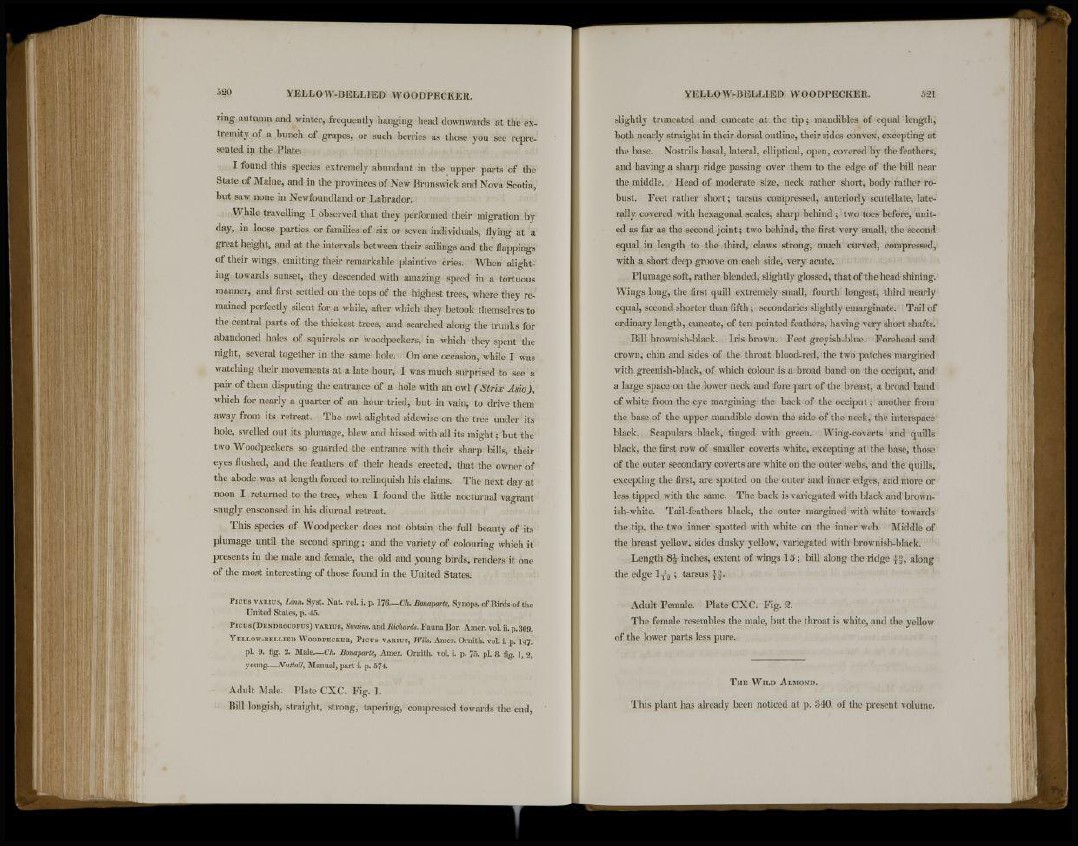
520 YELLOW-BELLIED WOODPECKER.
ring autumn and winter, frequently hanging head downwards at the extremity
of a bunch of grapes, or such berries as those you see represented
in the Plate.
I found this species extremely abundant in the upper parts of the
State of Maine, and in the provinces of New Brunswick and Nova Scotia,
but saw none in Newfoundland or Labrador.
While travelling I observed that they performed their migration by
day, in loose parties or families of six or seven individuals, flying at a
great height, and at the intervals between their sailings and the flappings
of their wings, emitting their remarkable plaintive cries. When alighting
towards sunset, they descended with amazing speed in a tortuous
manner, and first settled on the tops of the highest trees, where they remained
perfectly silent for a while, after which they betook themselves to
the central parts of the thickest trees, and searched along the trunks for
abandoned holes of squirrels or woodpeckers, in which they spent the
night, several together in the same hole. On one occasion, while I was
watching their movements at a late hour, I was much surprised to see a
pair of them disputing the entrance of a hole with an owl (Strix Asio),
which for nearly a quarter of an hour tried, but in vain, to drive them
away from its retreat. The owl alighted sidewise on the tree under its
hole, swelled out its plumage, blew and hissed with all its might; but the
two Woodpeckers so guarded the entrance with their sharp bills, their
eyes flushed, and the feathers of their heads erected, that the owner of
the abode was at length forced to relinquish his claims. The next day at
noon I returned to the tree, when I found the little nocturnal vagrant
snugly ensconsed in his diurnal retreat.
This species of Woodpecker does not obtain the full beauty of its
plumage until the second spring; and the variety of colouring which it
presents in the male and female, the old and young birds, renders it one
of the most interesting of those found in the United States.
Picus VARIUS, Linn. Syst. Nat. vol. i. p. 176—Ch. Bonaparte, Synops. of Birds of the
United States, p. 45.
PICUS(DENDROCOPUS) VARIUB, Swains, and Richards. Fauna Bor. Amer. vol. ii. p.309.
YELLOW-REELIED WOODPECKER, PICUS VARIUS, Wils. Amer. Ornith. vol. i. p. 147»
pi. 9. fig. 2. Male.—Ch. Bonaparte, Amer. Ornith. vol. i. p. 75. pi. 8. fig. 1, 2 ,
young.—Nuttall, Manual, part i. p. 574.
Adult Male. Plate CXC. Fig. 1.
Bill longish, straight, strong, tapering, compressed towards the end,
YELLOW-BELLIED WOODPECKER. 521
slightly truncated and cuneate at the tip; mandibles of equal length,
both nearly straight in their dorsal outline, their sides convex, excepting at
the base. Nostrils basal, lateral, elliptical, open, covered by the feathers,
and having a sharp ridge passing over them to the edge of the bill near
the middle. Head of moderate size, neck rather short, body rather robust.
Feet rather short; tarsus compressed, anteriorly scutellate, laterally
covered with hexagonal scales, sharp behind ; two toes before, united
as far as the second joint; two behind, the first very small, the second
equal in length to the third, claws strong, much curved, compressed,
with a short deep groove on each side, very acute.
Plumage soft, rather blended, slightly glossed, that of the head shining.
Wings long, the first quill extremely small, fourth longest, third nearly
equal, second shorter than fifth; secondaries slightly emarginate. Tail of
ordinary length, cuneate, of ten pointed feathers, having very short shafts.
Bill brownish-black. Iris brown. Feet greyish-blue. Forehead and
crown, chin and sides of the throat blood-red, the two patches margined
with greenish-black, of which colour is a broad band on the occiput, and
a large space on the lower neck and fore part of the breast, a broad band
of white from the eye margining the back of the occiput; another from
the base of the upper mandible down the side of the neck, the interspace
black. Scapulars black, tinged with green. Wing-coverts and quills
black, the first row of smaller coverts white, excepting at the base, those
of the outer secondary coverts are white on the outer webs, and the quills,
excepting the first, are spotted on the outer and inner edges, and more or
less tipped with the same. The back is variegated with black and brownish
white. Tail-feathers black, the outer margined with white towards
the tip, the two inner spotted with white on the inner web. Middle of
the breast yellow, sides dusky yellow, variegated with brownish-black.
Length 8^ inches, extent of wings 15; bill along the ridge {g, along
the edge 1 ^ ; tarsus
Adult Female. Plate CXC. Fig. 2.
The female resembles the male, but the throat is white, and the yellow
of the lower parts less pure.
THE WILD ALMOND.
This plant has already been noticed at p. 340. of the present volume.